CHINA
Society

Society
Cities in CHINA
| Beijing |
Society
Central state structure
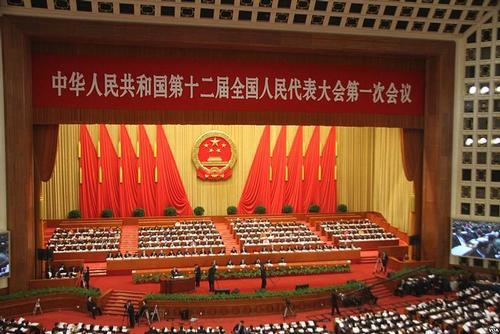
In 1982, the constitution still in force today was adopted, Article 1 of which reads as follows: “The People's Republic of China is a socialist state under the democratic dictatorship of the people, led by the working class and based on the alliance of workers and peasants. The socialist system is the fundamental system of the People's Republic of China; sabotage of the socialist system by any organization or individual is prohibited”.
Before this constitution entered into force, there was the Common Program of September 29, 1949 and constitutional revisions of 1954, 1975 and 1978. The new 1982 Constitution effectively ended the Mao Zedong period. It is striking that Marxist-Leninist cries such as "class struggle" and "dictatorship of the proletariat" are no longer reflected in the new constitution.
Article 1 of the constitution is still enforced by the Chinese Communist Party (CCP), and in practice its party is hardly distinguishable from each other. China is formally no longer a one-party state, but the CCP's monopoly position is evident.
The highest body of the CCP is formally the National Party Congress, which meets once every five years. The Central Committee, which has about 200 members, performs the functions of the Party Congress when it is not in session. It meets in plenary session once or twice a year. The Central Committee elects the Politburo and the Politburo Standing Committee, where real political power is concentrated, headed by Secretary-General.
At the 15th Party Congress in 1997, Deng Xiaoping's "open-door" policy was elevated to official party doctrine. This policy has made possible the economic developments of the last decades.
The National People's Congress, the Chinese Parliament, formally holds the highest state authority. The current NPC has about 3000 members, who have been elected indirectly for a period of 5 years and meet once a year. This session takes place in March-April for two to three weeks. Although officially vested with the highest state authority, the role of the NPC mainly consists of ratifying decisions taken by the CCP top and submitted to the NPC through the State Council.
The powers of the People's Congress have been extended in the new Constitution to monitor compliance with the Constitution and the laws and to decide on issues of war and peace. In addition, Congress approves government economic policies and the state budget.
However, in recent years the annual plenary sessions have been increasingly openly debated.
The delegates are elected by the provinces, the self-governing areas, the urban regions under direct central authority and the armed forces.
The head of state in the People's Republic of China is the President, who is assisted by one Vice President. The President and Vice President may be elected for up to two five-year terms.
The President is also Secretary General of the CCP and Chairman of the Central Military Commission.
The State Council is the central government, making it the highest executive of the People's Republic of China. The State Council is the executive body of the National People's Congress and the Standing Committee, on the one hand, and the supreme governing body of the State, on the other. The State Council includes the Prime Minister, the Deputy Prime Ministers, the Ministers and the Ministers who head committees.
A permanent committee of approximately 150 members is elected from the congress. This committee has very wide powers, including those to interpret the law and to issue decrees. In addition, the committee may revoke or amend incorrect decisions of the provincial governments, autonomous regions and directly governed cities, and decide on the appointment and dismissal of members of the state council.
The committee can also take decisions on ratification and termination of treaties. The chairman of the committee holds the position of head of state in many respects. For the current political situation, see chapter history.
Decentralized state structure
The local organs of state power are the local people's congresses at the different levels, in descending order:
1. provinces and urban regions under direct central authority;
2. prefectures, cities and districts;
3. townships and smaller cities.
The popular congresses at the three levels are elected for five, three and two years respectively. Their powers are not very clearly defined in the constitution. In any case, they elect the local revolutionary committees and may also dismiss their members.
Local executive power rests with the local revolutionary committees, which are both permanent bodies of the local people's congresses and the local people's government at their level. These revolutionary committees are accountable to both their people's congress and the next higher state body. The People's Congresses and their revolutionary committees ensure the implementation of laws and decrees in their area, decide on local economic plans and budgets, and maintain order and safeguard citizens' rights.
The constitution contains separate rules on the self-governing bodies of the national autonomous regions. These areas, in descending order of magnitude: self-governing areas at the provincial level, prefectures and districts, have, in parallel with ordinary administrative units, popular congresses and revolutionary committees, which exercise self-government within limits defined by law. The higher state organs safeguard and control the exercise of self-government. There are five autonomous regions, Inner Mongolia (Nei Monggol), Guangxi Zhuang, Ningxia Hui, Tibet (Xizang) and Xinjiang Uygur. All autonomous regions are inseparable parts of China.
In 1997, China regained control of the former British crown colony of Hong Kong, which retained its own economic rules. In 1999, China regained control of Macau, which has been officially recognized as Chinese territory since 1973, but was still administered by Portugal.
Both have the status of “Special Administrative Region”, which means that there is a different political, legal and economic system than in the rest of China. Hong Kong and Macau can maintain the capitalist system of governance for fifty years. Only the responsibility of foreign policy and defense rests with the central government in the capital Beijing.
Administrative division
 Administrative Divisions of ChinaPhoto: Lorenzarius CC 3.0 Unported no changes made
Administrative Divisions of ChinaPhoto: Lorenzarius CC 3.0 Unported no changes made
China is divided into 22 provinces, five autonomous regions, four urban areas or municipalities under the direct authority of the central government in Beijing. The provinces and autonomous areas are divided into departments or prefectures and these into districts. After all, the districts include the cities and the people's communes or townships. China also includes the Special Administrative Regions of Hong Kong and Macau.
| Province | Capital city | Population |
| Anhui | Hefei | 60 million |
| Fujian | Fuzhou | 35 million |
| Gansu | Lanzhou | 26 million |
| Guangdong | Guangzhou | 87 million |
| Guizhou | Guiyang | 36 million |
| Hainan | Haikou | 8 million |
| Hebei | Shijiazhuang | 68 million |
| Heilongjiang | Harbin | 37 million |
| Henan | Zhengzhou | 93 million |
| Hubei | Wuhan | 60 million |
| Hunan | Changsha | 65 million |
| Jiangsu | Nanjing | 75 million |
| Jilin | Changchun | 28 million |
| Liaoning | Shenyang | 43 million |
| Qinghai | Xining | 5 million |
| Shaanxi | Xi’an | 36 million |
| Shandong | Jinan | 90 million |
| Shanxi | Taiyuan | 33 million |
| Sichuan | Chengdu | 84 million |
| Yunnan | Kunming | 43 million |
| Zhejiang | Hangzhou | 47 million |
| Autonome regio’s | Capital City | Population |
| Guangxi | Nanning | 45 million |
| Binnen-Mongolië | Hohhot | 24 million |
| Ningxia | Yinchuan | 6 million |
| Xinjian Uyghur | Urumqi | 20 million |
| Tibet | Lhasa | 3 million |
| Urban areas | Population |
| Beijing | 31 million |
| Shanghai | 17 million |
| Tianjin | 10 million |
| Chongqing | 31 million |
| SAR | Populaton |
| Hongkong | 7,3 million |
| Macau | 0,5 million |
Education
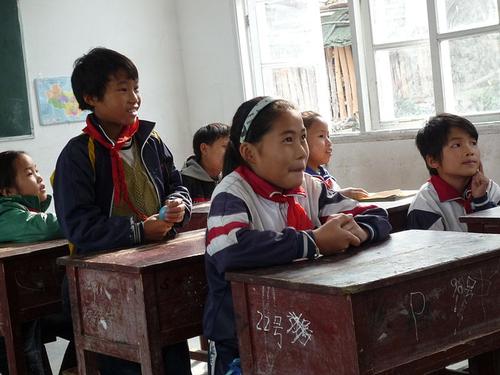 School class in ChinaPhoto: Thomas Galvez CC 2.0 Generic no changes made
School class in ChinaPhoto: Thomas Galvez CC 2.0 Generic no changes made
From a very early age, Chinese children can be cared for in creches, when parents cannot arrange care at home. The problem is that there is a great lack of creches, especially in the cities. Many creches belong to the working unit of one of the parents.
At the age of six / seven, Chinese children enter primary school. This lasts five years, with the children spending 24-27 lessons a week at school for 40 weeks each year. The most important subjects are reading, writing and calculating with knowledge subjects in the higher classes and possibly a foreign language, often English. Attention is also paid to sports, culture and ethics.
After primary school, middle school follows, which is divided into three years of primary school and two or three years of higher middle school. Main subjects are language and literature, mathematics, physics, history and foreign languages. In addition, physical and mental training is given in the subjects of sport and politics and productive work is carried out for 1-2 weeks per semester.
The best students of the middle school can transfer to a university through very strict entrance exams. The duration of a university study is three to four years for a basic program and five to six years for certain studies.
There are many universities in China, but they vary greatly in quality. In 2001, China had 1,225 universities and high education institutions. More than 7 million people received training at these institutions. More than 80,000 students followed a course abroad. The top universities are Beijing University and Fudan University of Shanghai; they can compete with western universities. Many provincial and local "universities" have a much lower quality.
Despite compulsory education, in 2000 approximately 85 million people over the age of 15 were illiterate or could barely read and write. Illiteracy is highest in Tibet at 36%.
Typically China
CHINESE WALL (Wanli Changcheng)
The Great Wall of China is located in northern China and extends 4,430 kilometers from the sea in the east to beyond Jiayuguan in the Gobi Desert of Gansu. It is the only human-made structure visible from space.
The wall was built as early as the 7th century BCE, but the wall did not take its current form until under the first emperor of the Qin Dynasty, Qinshi Huangdi (221-210 BCE). Under the Han Dynasty, the wall extended into the Gobi Desert.
The aim of the defensive wall was to keep the enemy tribesmen away from the north of China, which, incidentally, completely failed.
Outside Beijing, parts have been restored, but for the most part, the wall zigzags through North China.
TERRACOTTA ARMY
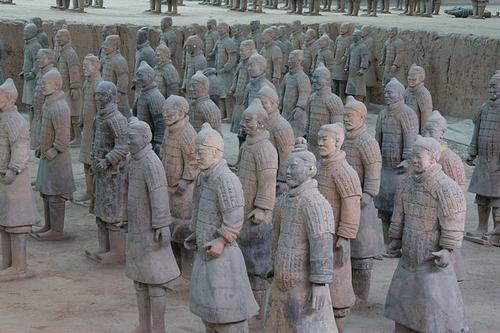 Terracotta Army ChinaPhoto: Maros M r a z CC 3.0 Unported no changes made
Terracotta Army ChinaPhoto: Maros M r a z CC 3.0 Unported no changes made
A few farmers digging a well in 1974 stumbled upon a 2,000-year-old army of about 8,000 terracotta soldiers and horses. The terracotta army was buried in the outer wall of the imperial mausoleum during the reign of Emperor Qinshi Huangdi.
The largest soldier is over 6 feet (1.8 meters) tall, and they were all equipped with swords, spears, crossbows, and handbows. The soldiers and horses were baked from yellow clay.
KUNG FU
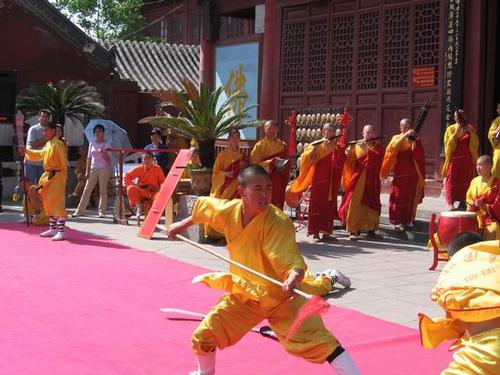 Kung Fu ChinaPhoto: Asteiner CC 3.0 Unported no changes made
Kung Fu ChinaPhoto: Asteiner CC 3.0 Unported no changes made
Kung fu means "skill" and that can be a perfect mastery of a form of war, but also of calligraphy or painting, for example.
However, Kung Fu is inextricably linked to the image of a fearless, skilled fighter. The accent of a real kung fu is not so much on suppleness as on the ability to quickly transition from the ethereal to a solid base. It is an inner skill, rather than an outer trick.
There are two groups of fighting techniques: the "soft" or "inner" direction and the "hard" or "outer". Taiji quan or tai chi, with its slow movements, characterizes the first school, while baimei quan, characterized by ferocious and rapid dropouts, belongs to the latter category.
The soft forms take Taoism as a starting point, the hard forms Buddhism.
CHINESE CERAMICS
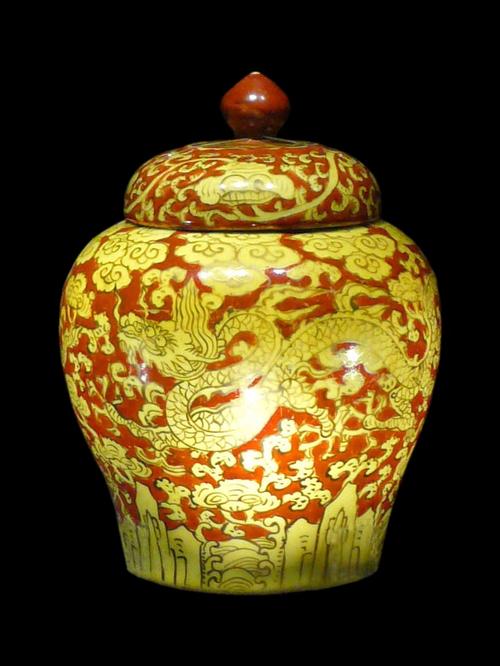 Chinese Ceramics ( Ming)Photo: Jbarta CC 2.0 Generic no changes made
Chinese Ceramics ( Ming)Photo: Jbarta CC 2.0 Generic no changes made
Famous all over the world, Chinese porcelain has a long and rich history dating back to Neolithic times. Probably during the Zhou Dynasty, the important glaze development took place, perfected during the Han Dynasty.
Porcelain made its appearance during the Tang Dynasty, and much remains from the Song and Yuan Dynasties. During the Yuan Dynasty, a cobalt blue underglaze (qinghua, or blue-white) penetrated from the Middle East, a technique that flourished during the Ming and Qing dynasties. Blue and white is often thought to be characteristic of the Ming period, but the style peaked during the Qing Dynasty.
Ceramics were often named after the place where they were baked, so that they got names like Jingdezhen, Dehua and Longquan.
Chinese ceramics are often decorated with symbols, such as the dragon, the phoenix, peaches, pine, turtles and bamboo.
Chinese ceramics are categorized by color and enamel. The mark, by which the date of manufacture can be determined, is located on the bottom of the workpiece. It is usually square or round, with the name of the dynasty preceding that of the emperor, read vertically from right to left.
TRADITIONAL CHINESE MEDICINE
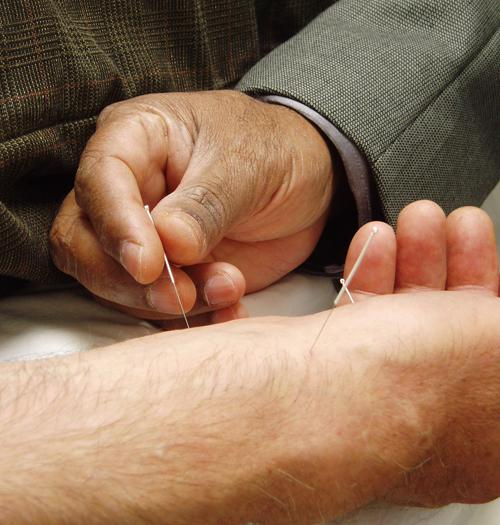 Acupuncture ChinaPhoto: Public domain
Acupuncture ChinaPhoto: Public domain
Traditional Chinese medicine not only consists of acupuncture, but has many applications, all of which are based on Taoist principles.
For Chinese doctors, the function of the organs in the distribution of life energy or "qi" in the body is very important. Over the centuries, hundreds of points on the body have been identified that are connected to the organs. Connecting these points creates a system of meridians, along which the flow of the 'qi' can be read.
There are twelve meridians, each corresponding to one of the five Chinese elements of iron, earth, fire, water and wood, which are best treated at a specific time of the day.
Illness arises from a lack of harmony between body and mind, for example when emotional tensions disturb the natural balance. A Chinese physician examines the flow of "qi" through the meridians through the pulse. By varying the pressure of the fingers, he can notice irregularities.
The physician's goal is to stimulate the flow of "qi" in a blocked meridian. He can do this with acupuncture ("zhenjiu"), acupressure, heat treatment with needles and burning moksa (moxibustion), or massage ("anmou"). Good nutrition is also very important. Taoism teaches abstinence from all kinds of food and drink, and one should only eat food related to the organs and the elements.
CHINESE SILK
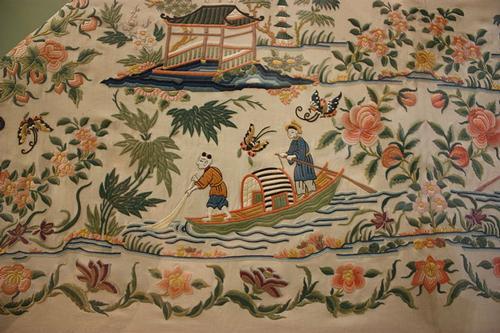
Chinese silk production is approximately 46,000 tons annually. Much of it is exported and China controls 90% of the world raw silk market.
Sericulture (Greek: serikos means silk) refers to the cultivation of silkworms and the production of raw silk. Farmers grow the silkworms and deliver the cocoons to the spinning mill, where the raw silk is wound on a spool.
The silkworm is the larva of the moth Bombyx mori, which is native to China. They feed on the leaves of the mulberry tree and when they are fully grown they make cocoons. The threads from six or seven cocoons are needed to make a fiber strong enough to weave.
CHINESE ASTROLOGY
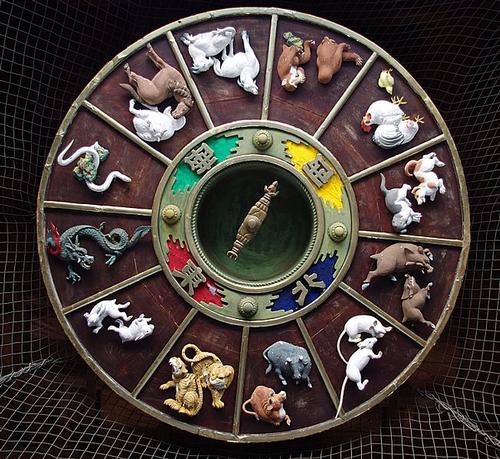
Chinese Astrology works with the following zodiac symbols in the following order: rat, ox, tiger, rabbit, dragon, snake, horse, goat, monkey, rooster, dog and pig.
The core of Chinese astrology is the study of the interaction between people, about 12 fundamental character types and the relationships between them.
The 12 animals do give a good description of the different personality types, but most people are not pure types, but have the characteristics of several animals. Each person is composed of three animals:
-one animal for the year of birth
-one animal for the month of birth
-one animal for the time of birth, also called the ascendant animal
For the year of birth, an element must also be taken into account. Each of the 12 animals has a further five variations based on the 5 elements: Earth, Metal, Water, Wood and Fire. A wood monkey therefore only occurs during one year for 60 years.
Based on this, there are already 60 basic types. Moreover, the Chinese astrologer also takes into account the month, a different animal per lunar cycle. Furthermore, the day is divided into 12 pieces of 2 hours and this way you already have 8640 possibilities.
Sources
China
Cambium
China
Informatie Verre Reizen
Eijck, F. / Reishandboek China
Elmar
Floor, H. / China
Stichting Teleac
Harper, D. / China
Kosmos-Z&K,
Jansen, I. / China
Gottmer/Becht
Knowles, C. / China
Van Reemst
MacDonald, G. / China
Kosmos-Z&K
CIA - World Factbook
BBC - Country Profiles
Last updated November 2025Copyright: Team The World of Info